With Audi's introduction of the Audi R8 V12 TDI, we got to look at the most unique aspect of this supercar - its diesel engine. Compression-ignition motors may be commonplace everywhere else in the transportation world, but they haven't yet infiltrated the supercar segment. This is no accident, as until now, diesels have offered a poor ratio between power output and weight - not a big problem for cruise ships and the like, but definitely an obstacle to recruiting a high-performance customer. So, how did Audi get around this problem? We've got a gallery full of shots showing the naughty details (you can access it by clicking the photo above or the link below), and if you go below the fold, we'll walk you through what we observed of the engine on display.
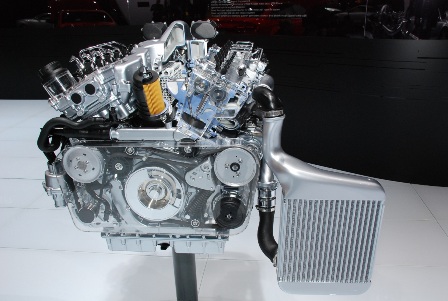
While Audi's race-winning V12 engines use a 90-degree bank angle to minimize the trade-offs between packaging, center-of-gravity and aerodynamics, the R8's street-going version will use a 60-degree angle. This makes it a better fit for the narrower engine compartments of not just the R8, but also the A8 and Q7.
The display engine only showed a single intercooler - if this were a complete assembly, you'd see another one on the left side of the shot.
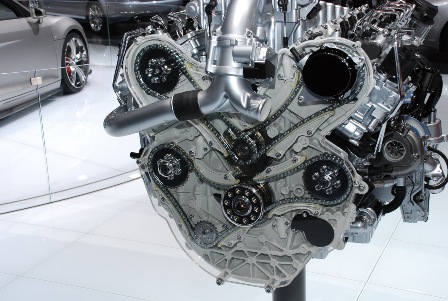
The camshafts are driven off what we'll refer to as the rear of the engine (the side opposite of the accessory drive). A set of spur gears transfers the rotation of the crankshaft to a jackshaft, which then drives the cams via individual chains. On the right side bank, you can see the actuator for the variable valve timing.
The chains that are driven directly from the crank are used to spin the fuel injection pumps - one per bank to handle the requirements of delivering 500 HP. The left-side chain also appears to drive the oil pump.
Note that the crankshaft uses a whopping ten M12 fasteners to transmit all 738 lb-ft of torque to the flywheel.
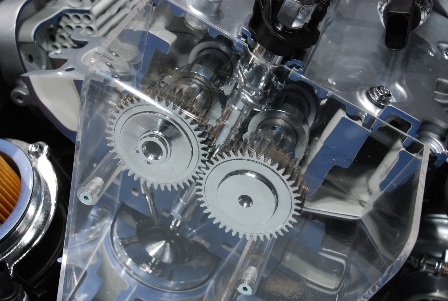
While the camshafts are driven from the rear of the engine, they're timed together by these small spur gears at the front. Note the straight-cut gears, which probably lend a lovely mechanical sound at higher engine speeds.
Judging by the appearance of the cams, they're built-up from several individually-fabricated lobes that are then pressed on to a hollow steel tube. This results in a lighter and potentially less-expensive camshaft than those fabricated using the traditional casting and grinding methods.
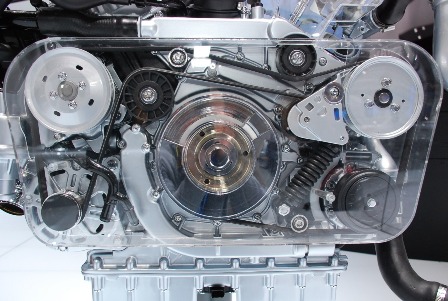
The accessory drive appears to do a great job of minimizing packaging space and keeping the heavy components. You can see the alternator at the lower left, while the A/C compressor sits on the bottom half of the right side. Lighter components, such as the power steering pump, are located higher on the engine.
The spring on the belt tensioner is about the beefiest we've ever seen!
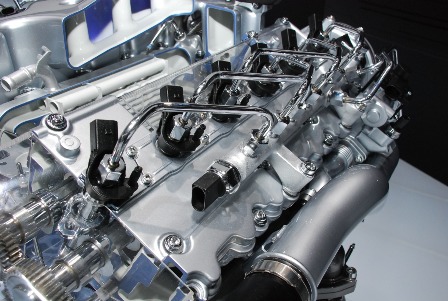
Each bank feeds its injectors via a common rail that is secured to the valve cover. The electrical connector at the end of the rail is for the fuel pressure sensor.
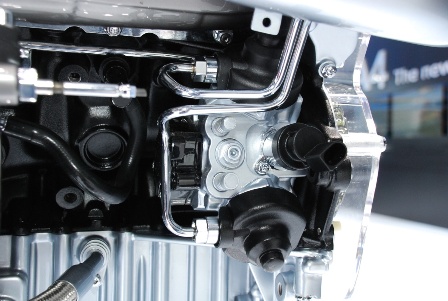
Here are the injection pumps, which are tasked with taking fuel at low pressure from the fuel tank transfer pumps and pressurizing it to a whopping 29,000 PSI. At this pressure, liquids no longer behave like incompressible fluids, and it becomes extremely critical to avoid any resonances caused by transient events (such as the injectors opening and closing several times per combustion cycle).
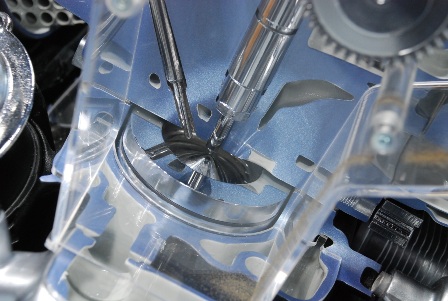
Compared to the rest of the engine, the combustion chambers are rather straightforward - they utilize four valves clustered around a central injector, with a glow plug to assist during cold starts. It's not clear if these glow plugs are capable of measuring cylinder pressure, which is a new technology that would be of immense assistance in controlling the combustion process.
The intake and exhaust passages on this engine don't appear to be impressively large, but it's important to remember that each cylinder only needs to support about 42 HP worth of airflow.
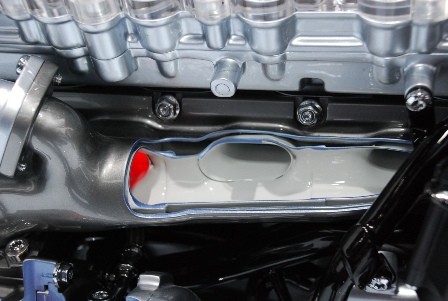
The exhaust manifolds are constructed from tubular steel, and feature double walls to improve their insulating qualities (this also helps reduce noise).
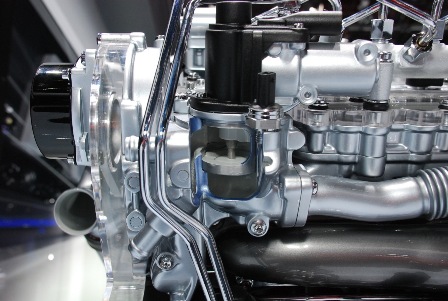
The plumbing and poppet valve shown here are the primary means of controlling exhaust-gas recirculation (EGR), which is so critical to minimizing the oxides of nitrogen (NOx) emissions of modern diesel engines. After the gases flow through the control valve, they're routed through a passage in the cylinder head towards the interior of the engine.
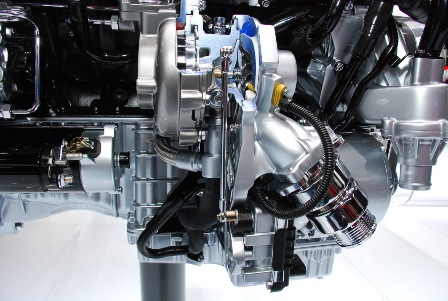
Mounted low on the engine are the turbochargers, one per bank. The variable-vane geometry is controlled by an electromechanical actuator via a pushrod - a configuration that keeps the electronics well away from the red-hot exhaust turbine.
Each turbocharger also appears to contain an exhaust gas temperature (EGT) sensor, which might assist the engine management system in extracting maximum power in the most reliable manner.
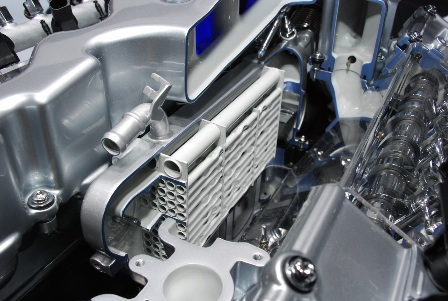
Nestled deep in the valley of the V12 is one of the largest EGR coolers that we've ever seen. It's an attractive place to put this cooler, as it's adjacent to water passages, and the space would otherwise be difficult to utilize.
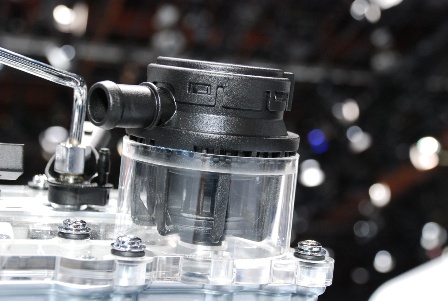
A large breather valve resides on each valve cover, and helps to recover vapors from the large amount of oil that likely makes its way to the top of the cylinder heads during spirited driving. Maintaining a vacuum on the crankcase is critical to minimizing oil consumption, and trying to keep liquid oil from entering the intake manifold is no minor task.
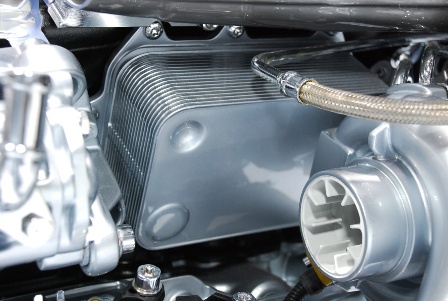
The engine oil cooler sits on the left side of the engine, tucked behind the turbocharge. "Cool" would appear to be a relative statement when talking about the temperature of this location.
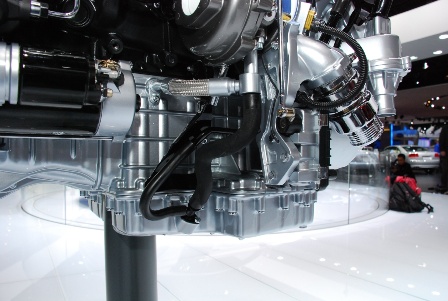
The oil pan contains wide kick-outs to help keep the lubrication system well-fed during acceleration events. The plumbing for the turbocharger lubrication can also be observed in this view.
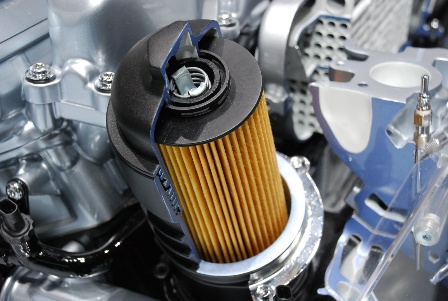
A cartridge-style oil filter resides on top of the engine, towards the front of the valley. The top of the canister unscrews to give easy access to the filter from the top side of the engine - if only all oil changes would be this easy.
There are several more photos in the gallery that I haven't included here, since they're mostly redundant. Still, if you're somehow left wanting for more...

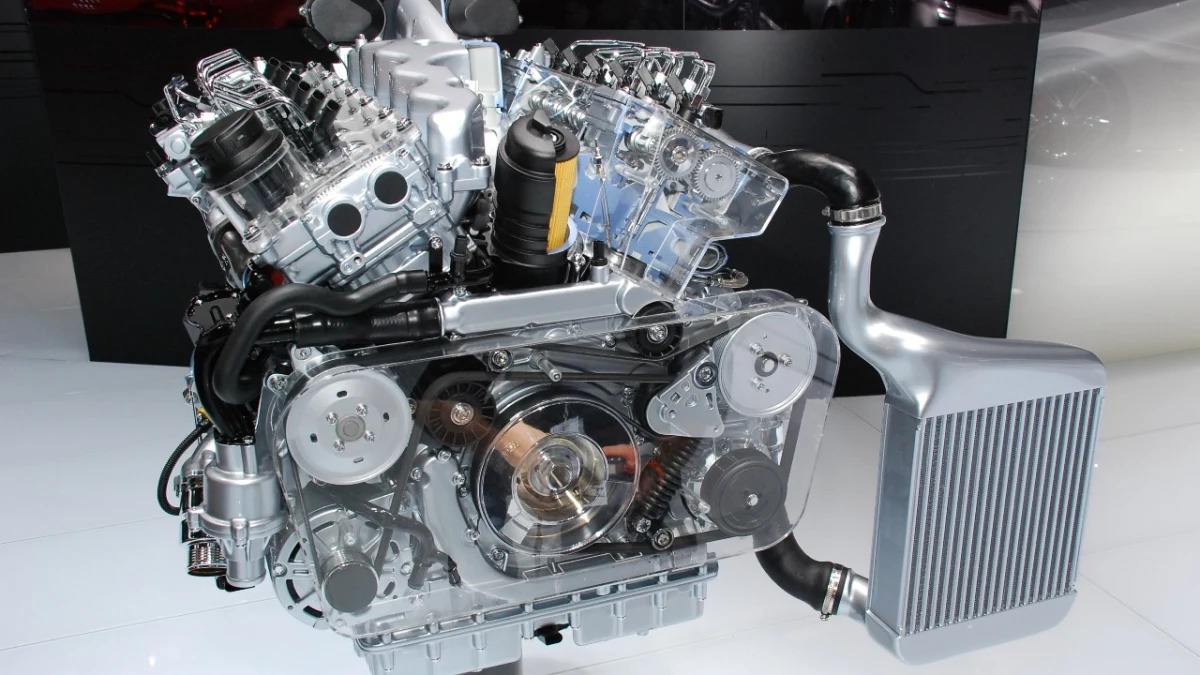

Sign in to post
Please sign in to leave a comment.
Continue